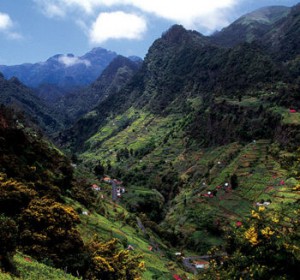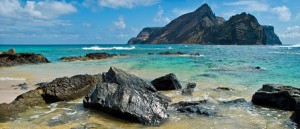 “The island of the flowers“, “the afloat garden” or “the spring island”: for the Portuguese island of Madeira there are different names. Placed in the Atlantic, around 1000 km south to Lisbon and 600 km west to Morocco; the island origins from a volcano, and together with Porto Santo and other bare and uninhabited islets constitute the homonymous archipelago.
“The island of the flowers“, “the afloat garden” or “the spring island”: for the Portuguese island of Madeira there are different names. Placed in the Atlantic, around 1000 km south to Lisbon and 600 km west to Morocco; the island origins from a volcano, and together with Porto Santo and other bare and uninhabited islets constitute the homonymous archipelago.
The climate is divided in rainy in the north and almost south-tropical in the south with mild temperatures the whole year: in summer the temperature can move from 25° to the 35° and in winter never goes down under 10°.
The towns and the countries of the island, that measures 57 Km of width and 22 of length, are primarily developed along the coasts. The central part is mountainous, dominated from imposing woods, with few houses isolated and dwarfish countries. Good part of the coasts precipitates on the sea, with deep bluffs up to 4000m.
The capital is Funchal, so called by the first Portuguese explorers, who found there a lot of wild fennel. The city counts around 45.000 inhabitants, including also the district reaches around 100.000 or 40% of the total population. Funchal is found in an idyllic bay in the south of the island, and it extends its terraces on the back hills; at night the illuminated city gives a splendid sight. There is a lot of movement during the day, in the evening predominantly only in the weekends. Since the morning it becomes animated with a lot of people, around for shopping in the small shops, in the commercial centres (traces of globalization are also glimpsed in these areas). The city invites to the discovery of his small but very nice parks, and to cross the roads of the centre among a crowd of small cafes, bars and restaurants. There are a lot of markets along the streets, which sell fresh fruit, flowers and souvenir, placed side by side by curious groups of elderly people that play cards… oddly sat anywhere except that at a table.
The local population is revealed very kind and available. We have also met a group of boys which have very appreciated Dolce Vita!
The capital is very modern. There are a lot of wi-fi internet points around city. Moreover there are the classic internet café really very cheap. The zone of the old city is full of small restaurants where is possible to taste the fish specialties (the most diffused is the barracuda) and to choose among the very good wines of the island.
From the port depart ferries they Porto Santo, boats for the observation of whales and dolphins and tour of the island on board of catamarans or of the characteristic “Saint Maria de Christopher Columbus” (reproduction of the original caravel of Christopher Columbus). In front of the port, there is the waterfront of the city, in centre you can find the coloured “Mercado dos Lavradores” and to north part the Botanical Garden of the city.
 The city lift will bring you to Monte: it is known for the traditional descents through the country on board of wicker sleighs, driven from crazy persons in typical white suits and straw hats (the roads of the country are however opened to the traffic!); moreover, the botanical garden “Mountain Palace Tropical Garden” is very appreciated, where cohabits a rich collection of palms, cactus, millennial olives, tropical, native and south American plants. Inside, an oriental garden has been created with pagodas, channels, bridges and paths in Japanese style, little ponds with carps koi and aquatic birds. At the entrance, a museum of three floors contains works of art coming from Africa.
The city lift will bring you to Monte: it is known for the traditional descents through the country on board of wicker sleighs, driven from crazy persons in typical white suits and straw hats (the roads of the country are however opened to the traffic!); moreover, the botanical garden “Mountain Palace Tropical Garden” is very appreciated, where cohabits a rich collection of palms, cactus, millennial olives, tropical, native and south American plants. Inside, an oriental garden has been created with pagodas, channels, bridges and paths in Japanese style, little ponds with carps koi and aquatic birds. At the entrance, a museum of three floors contains works of art coming from Africa.
The net of public transports has contained costs and it allows to easily move in the city and in the adjacent places; to explore the whole island, as we said mountainous (at the most 10% of level surface), it is necessary to rent an auto. In the 90’s the high – way has been built, with different tunnels and bridges, that have brought practicality for the travellers but “cemented” the environment. Who would like to enjoy of hidden places and splendid panoramas with bluffs peaking on the sea, we suggest you to take some time and to cross the old roads, however still in good state.
Travelling toward west, you can reach Camara de Lobos, that takes the name from the sea lions that live in the zone, but they are predominantly hidden: it is in fact very rare to see one of it. At a very little distance you can see Cabo Girao , the second tallest bluff on the sea in the world, to the feet of which there is the so-called Faia dos Padres, “the priests’ Earth”. Here you can fin the best Madeira Wine (a liquorish wine very similar to the Marsala). Up to 1998 it was reachable only from the sea, while today there is a panoramic elevator in glass.
Towards west, crossing small suburbs of fishermen and wide plantations of bananas, you can reach Calheta, where there is the only beach of sand inside an inlet, and a tourist port that offers different sporting activities. A little farer, Paul do Mar, other heaven of the surf. In this bay the waves can reach different meters of height: the surfers in sea complete the picture of this fantastic natural show. The small suburb to the feet of a steep precipice, has always been rather isolated and only from the end of the years ’60 is reachable by earth. Before then the only street was the sea. Paul do Mar is the main point of the island for fishing, and obviously the best restaurants in Madeira with specialty of fish are here.
Holds and tortuous roads through the woods conduct us up to Porto da Moniz, the point more to the north of the island. From the waterfront extends a landscape of enormous rock-cliffs, inside which a restaurant and an aquarium have been built (it’ s worthy to visit them). Then you will find a complex of natural swimming pools, edged by eccentric heaps of rock-cliffs full of crystalline water that the tides always handle to furnish (inclusive fishes). The ideal place to relax at the sun, to make the bath and to enjoy the beauty of the environment and the sea that unloads its strength against the rock-cliffs.
More to east, at Sao Vicente, there is the centre of volcanology, that offers a look on the origins of the island and driven visits through volcanic caves formed 400.000 years ago in the phase of unloading of lava toward the sea at the end of the activities: they measure around 1 km, of which only 700 ms practicable.
 Inside the island the dense woods hide different natural beauties: Pico do Arieiro (1818m) and Pico Ruvio (1861m), the tallest mountains of the island. Curral das Freiras is found in a very deep valley, to built to the times of the raids of the pirates, when the inhabitants of the coast moved there looking for a well protected position. Today it is known for the gastronomic specialties based on chestnuts. The wealth of green and woods invites to excursions along the paths that joint on one side to the other of the island; particularly appreciated are those near Levadas (which is a system of artificial falls). At Camacha a traditional activity is the art of the wicker interlacement: objects of any type are built. In the principal “plaza” you can find one of these laboratories, that also acts as shops, and a show of exposure for particular and artistic compositions. Santana, to northeast, it is a small place declared recently from the UNESCO as patrimony of the humanity. The worth goes to the typical traditional houses, dwarfish residences made of stone with a straw roof that reached the floor. Still today some of them are inhabited, but the most part have been restructured to benefit of the tourists.
Inside the island the dense woods hide different natural beauties: Pico do Arieiro (1818m) and Pico Ruvio (1861m), the tallest mountains of the island. Curral das Freiras is found in a very deep valley, to built to the times of the raids of the pirates, when the inhabitants of the coast moved there looking for a well protected position. Today it is known for the gastronomic specialties based on chestnuts. The wealth of green and woods invites to excursions along the paths that joint on one side to the other of the island; particularly appreciated are those near Levadas (which is a system of artificial falls). At Camacha a traditional activity is the art of the wicker interlacement: objects of any type are built. In the principal “plaza” you can find one of these laboratories, that also acts as shops, and a show of exposure for particular and artistic compositions. Santana, to northeast, it is a small place declared recently from the UNESCO as patrimony of the humanity. The worth goes to the typical traditional houses, dwarfish residences made of stone with a straw roof that reached the floor. Still today some of them are inhabited, but the most part have been restructured to benefit of the tourists.
The point more at east of Madeira, Ponta de Sao Lourenco, is an arid peninsula of hills of rocks on the sea. For a long time nearly uninhabited, it has become a natural reserve. An excursion through this rocky landscape offers a sight on the open sea, on the rest of the island and in the clear days also of the island of Porto Santo, far 70 kms.
To the feet of this landscape there is Canical. Here you can find the museum of the hunting to the whales from 1981 (year of the interruption of the activities of hunting), the commercial harbour and the “open” zone of Madeira.
Around 3 more kms to the south you can find Machico, the second city of the island in order of greatness and the most interesting to historical level: the first Portuguese explorers landed in this bay; there are here the most ancient churches and two forts used at the times of the raids of the pirates. Returning toward Funchal you will cross SantaCruz, a little town of fishermen, a small market and a beach (of stones) coasted by palms and boats. Nearby there is the airport of the island, widened in 2000. The airstrip of 2781m, built with pylons and plates of cement on the sea, it also allows the traffic of great airplanes. In case of direct flights from Italy, it is necessary to consider a stop to Lisbon, but to spend a period of vacation on this island, even in an out season period… it’s really worthy!
Edited by EVELIN & MAURIZIO
Info: madeira-web.com
From: Dolce Vita International 2




